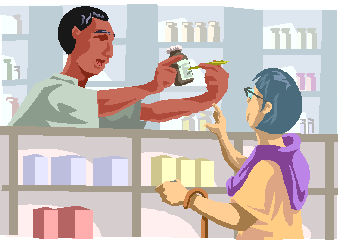Fill in the missing items in this word class table using a dictionary if necessary. Where there is a dash (—) you do not need to write anything
| Verb | Noun (a thing or an idea) | Noun (a person or an object) |
| — | pharmacy | |
| drug | ||
| prescribe | — | |
| label | — | |
| separatist | ||
| rubber | ||
| supplier | ||
| dispensary | ||
| — | chemist's | — |
5. What does a pharmacist use the following things for?
Example: Prescription For delivering medicines
1. refrigerator a) for keeping poisonous drugs
2. drug cabinet b) for keeping drugs in a cold place
3. labels of green colour c) for indicating drugs used for injections
4. labels of blue colour d) for indicating medicines for internal use
5. labels of yellow colour e) for indicating drugs for external application
6. labels of pink colour f) for keeping tablets and powders
7. boxes g) for indicating drugs used for treatment of eyes diseases
8. open shelves h) for keeping liquid medicines
9. small bottles i) for keeping herbs and medicinal goods
10. medicine droppers j) for mixing them and preparing drugs
11. balance k) for dropping medicines
12. glass cups l) for keeping medicines tightly closed
13. glass tube n) for holding and carrying liquids,
14. ingredients m) for weighing ingredients
6. Learn some job titles connected with a chemist's shop. Which of the job titles would be best to describe the following? Try to work from memory. Compare your answers with your partners.
a manager
a dispensing pharmacist
a chemist inspector
a chemist analyst
a pharmacist
- A person who is in charge of the supply of necessary drugs.
- A person who controls effectiveness of the drug prepared at the chemist's.
- A person who directs the affairs of the pharmacy.
- A person who controls the prescriptions, that is, physical, physicochemical and pharmacological compatibility of the ingredients.
- A person who takes prescriptions and delivers drugs.
VIII. Speaking.
1. Read and translate the quotation. Divide into-two groups: group 1 students agree with
the idea of N. Bonoparte; group 2 students have quite an opposite idea.
Medicine is a collection of uncertain prescriptions, the results of which, taken collectively, are more fatal than usual to mankind. Water, air and cleanliness are the chief articles in my pharmacopoeia.
(N. Bonaparte)
2. Read the proverb, translate it. Comment and discuss it in groups.
Remedy may be worse than the disease.
IX. Supplement.
Read the following text. Put questions and retell it.
COMMUNITY PHARMACY
A pharmacy (commonly the chemist's in Australia, New Zealand and the UK; or drugstore in North America; retail pharmacy in industry terminology; or Apothecary, historically) is the place where most pharmacists practice their professional habits. It is the community pharmacy where the dichotomy of the profession exists — health professionals who are also retailers. Community pharmacies usually consist of a retail storefront with a dispensary where medications are stored and dispensed.
The dispensary is subject to pharmacy legislation; with requirements for storage conditions, compulsory texts, equipment, etc., specified in legislation. Where it was once the case that pharmacists stayed within the dispensary compounding/dispensing medications; there has been an increasing trend towards the use of trained pharmacy technicians while the pharmacist spends more time communicating with patients. All pharmacies are required to have a pharmacist on-duty at all times when open. In many jurisdictions, it is also a requirement that the owner of a pharmacy must be a registered pharmacist (R. Ph.).

This latter requirement has been revoked in many jurisdictions, such that many retailers (including supermarkets and mass merchandisers) now include a pharmacy as a department of their store. Likewise, many pharmacies are now rather grocery store-like in their design. In addition to medicines and prescriptions, a lot of establishments sell a diverse arrangement of additional household items such as cosmetics, shampoo, office supplies, confectionary, and snack foods.
